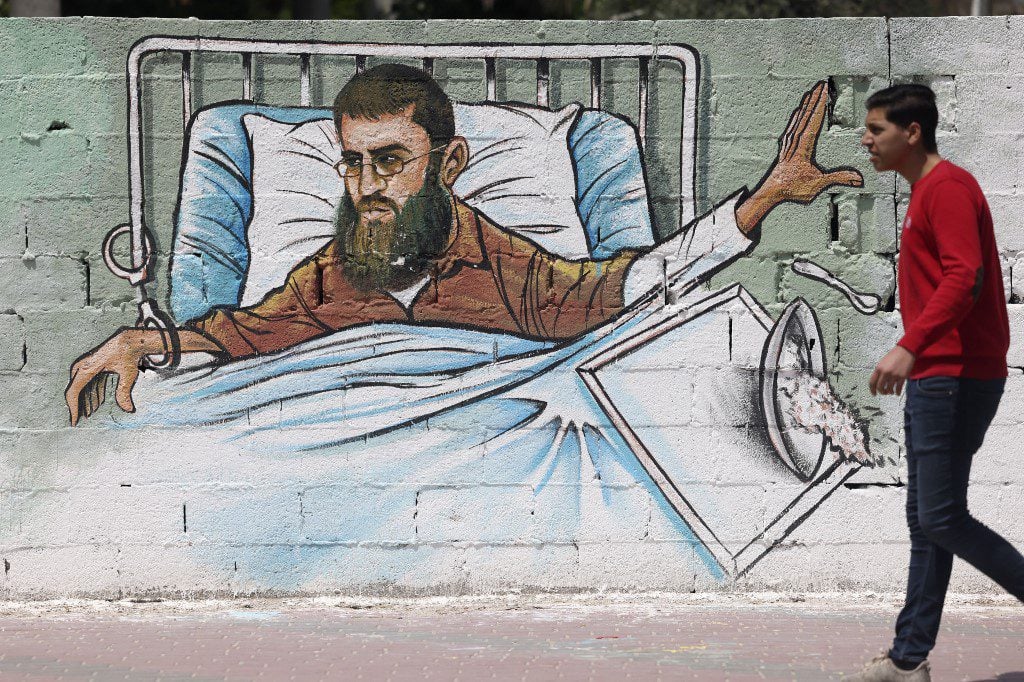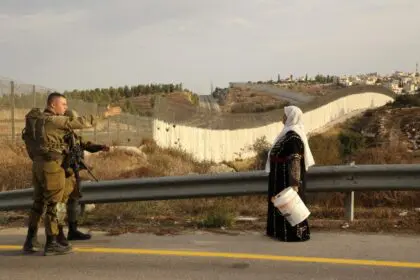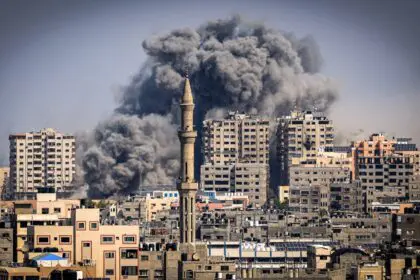The Palestinian Prisoners Movement plays a vital political and social role in shaping the national struggle against the Israeli occupation.

Youssef Sharqawi
The Palestinian Prisoners Movement has played a prominent role in Palestinian history. Moreover, it has mobilised the Palestinian street and shaped public opinion politically, culturally, and socially.
Since its inception, the Prisoners Movement has, despite difficulties, contributed significantly to the Palestinian cause. To its credit, the Movement rejected the division of Palestine and called for democracy and reconciliation among all Palestinian factions.
History and Inception
The Palestinian Prisoners Movement encompasses all those who have been imprisoned up until today, particularly following Israel’s occupation of the West Bank and Gaza Strip in 1967. According to historian Raafat Hamdouna, the term also includes females.
Since the beginning of the occupation, Israel has arrested “thousands of women, including mothers, minors and elderly, who participated in the resistance, or raised their voices demanding the restitution of their rights and their stolen land.”
In his study The History of the Palestinian National Prisoners Movement, Hamdouna argues that the Movement’s roots are not limited to 1967 but go back to the British Mandate for Palestine.
In 1930, the British imprisoned and executed rebels in Akka (Acre), including Ata al-Zeer, Mohammad Jamjoom and Fu’ad Hijazi. In 1937, Farhan al-Saadi was executed following his arrest. And in 1939, Yusuf Abu Durra Jaradat met the same fate.
A member of the Prisoners’ Committee of the Palestinian National and Islamic Forces, Abdul Qadir Idris, agrees with Hamdouna. In an interview with Fanack, Idris stated, “In 1930, the British Mandate issued a series of life sentences against 23 Palestinian revolutionaries.
In addition, it arrested the Palestinian people in Jerusalem, Akka (Acre), Safad, al-Khalil (Hebron) and all Palestinian territories. Perpetually renewed administrative detention affected a large number of Palestinians. The Israeli occupation continues to use this habit of the British military until now.”
Abdel Fattah Doula, a prisoner affairs researcher, told Fanack that the Movement’s early years were difficult. According to Doula, who spent 12 years in captivity, Israel’s oppressive practices are among the cruellest. “The goal of the occupation’s prison administration is to break the prisoner’s spirit.
Moreover, it aims to effectuate a disconnect between the prisoners and the Palestinian struggle and its intellectual context.”
He added, “The Movement needed a national struggle and confrontation that considered the capabilities of the captives in prison to restore prisoners’ dignity and provide better living conditions. In the late 1970s and early 1980s, prisoners rose up against the humiliating living conditions. The struggle began, and the Movement was born. It laid down the rules, spread awareness, educated, and unified collective action. The Movement organised open-ended hunger strikes, often referred to as “the battle of empty stomachs.” As a result, the Movement has reclaimed the patriotic state of the struggle and what it represents.”
Doula told Fanack about the humiliating and difficult conditions prisoners endured. One could only communicate with the outside world by writing on the foil of cigarette packs with pens smuggled in by lawyers.
“Such endeavours were difficult and risky. Subsequently, prisoners united in the ‘battle of empty stomachs.’ As the Prisoners Movement started to get organised, instead of being able to single out individual prisoners for psychological torture, the administration was now forced to deal with a representative of the prisoners.”
Academy in captivity
The Palestinian Prisoners Movement overcame the oppression in Israeli prisons. It turned prisons into places of academic and cultural education. Idris explained that “Over decades, the Movement made significant efforts for prisoners to be granted the ability to fulfil the basic needs – including the right to education – of which they had been deprived by the occupation.”
Idris continued, “The Movement has attained many scientific and cultural achievements, transforming prison cells into scientific and cultural academies. Hundreds of prisoners obtained a high school diploma, bachelor’s degree, master’s degree and doctorate while behind bars. Many prisoners have published numerous studies on their experiences of detention in Israeli prisons. They also published novels, books and poetry.”
Among the prisoners who have made outstanding scientific and cultural contributions is Walid Nimr Daqqa, who has been detained since March 1986. It should be noted that he suffers a spinal cord tumour and is subjected to deliberate medical negligence. Basem Khandakji, who provided the Palestinian National Library with many poetry collections, is another notable example. His collections talk about Palestinian alienation and the pain and hopes of the prisoners. The list also includes Nasser al-Shawish and Nasser Abu Srour.
Doula told Fanack about the Prisoners Movement’s challenges in promoting education in Israeli prisons: “The motto of the Prisoners Movement is ‘All for one and one for all.'” No captive ever enters Israeli prisons illiterate and comes out the same.
When a person enters prison, a specialised committee examines his educational and cultural level. If he is illiterate, the Literacy Committee takes care of him. He then progresses in education until he can write and read a detention leaflet.
Prisoners can pursue further education if they want. Al-Quds Open University has greatly helped since it opened a branch inside the prison. Today, a person can get a master’s degree in prison, and the programme is run by Marwan Barghouti.”
Doula adds, “The Prisoners Movement gave special care to cultural mobilisation and the struggle mindset. The occupation’s prison administration tried to prevent this awareness and education so that ignorance spreads, but ultimately failed.”
“The first demands of the Prisoners Movement were paper, pens and books. While the demand for these supplies continued, capsule smuggling had not stopped,” Doula told Fanack. “A capsule is a very small piece of paper with small writing and is folded until it is the size of a medicine capsule. It is wrapped in plastic, and the prisoner swallows it and takes it out later without facing any consequences,” he explained.
According to Doula, cultural committees are the most important. On top of philosophy, poetry and literature, these committees teach prisoners about revolutionary literature and approaches. He believes that “when a prisoner develops his sense of culture, he sets out to develop into other fields. When he reads literature and poetry, he develops even further.
Today, some of the most important contemporary Palestinian writers are in prison, and they qualify to be at the forefront of Arabic literature.”
Prisoner and Society
Prison separates prisoners from their social circles. However, prisoners continue the fight as an integral component of the Palestinian struggle. They, therefore, become part of the political and social discourse after their release.
“The prisoner is socially isolated; his family sees him for 45 minutes every month. Many prisoners are denied this visit,” Doula explained, “However, despite the limited communication with the outside, prisoners remain invested in their social circle, especially if they have been on the run before, for they are sure their community will protect them.”
“When a strike occurs inside the prison, a national movement occurs in parallel. This movement often forces the Israeli prison administration to submit to the prisoners’ demands,” he elaborated.
Regarding the status of prisoners in Palestinian society, Doula said, “Palestinian society holds captives in high regard since the Prisoners Movement has often contributed to solving society’s problems and issues.”
When the West Bank and Gaza Strip split, the Prisoners Movement proposed a solution from inside Israeli prisons. According to Doula, the national reconciliation document proposed by the Movement, headed by Marwan Barghouti and other faction leaders inside prison, “is the only valid one to embody a way out of the Palestinian division up to this point.”
Decision Making
Doula believes prisoners “are integral to the Palestinian decision-making process because they are the first to act.” He continues, “Freed prisoners have always been the leaders of the struggle and the political movement. The prisoners have played a vital role in decision-making and maintaining Palestinians’ connection to the national struggle and the pursuit of their rights. Their role is apparent in both social and political discourse.”
The Prisoners Movement has bent the laws and policies of the Israel Prison Service through open-ended hunger strikes. Several prisoners have died during these strikes, the latest of which was Khader Adnan, who went on strike for 87 days to protest his arbitrary detention. Adnan had previously waged strikes in protest of administrative detention without trial.
In 1980, three prisoners, Rasem Halaweh, Ali al-Jaafri and Ishak Maragheh, were killed in Nafha Prison as a result of being force-fed by the Israel Prison Service.
Through “the battles of empty stomachs,” the Prisoners Movement was able to keep the issue of arbitrary detention present in the conflict with the Israeli occupation. It rallied the masses to remain the noblest cause in the history of the struggle for freedom and independence.
Palestinians commemorate the 17th of April as Palestinian Prisoners’ Day. According to the latest statistics, the occupation detains around 4,900 prisoners, including 31 women and 160 children under 18.
There are currently 23 prisoners that have been incarcerated since before the Oslo Accords. Eleven of these prisoners were rearrested by Israel in 2014 after having been released as part of a prisoner exchange in 2011.
Approximately 400 “long-term prisoners” have spent over 20 years in prison.




